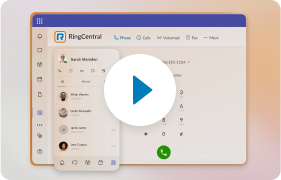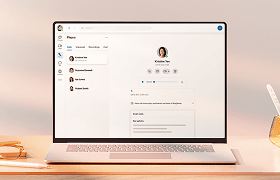High call volume signals business success, but it can quickly transform from a welcome challenge into a crippling bottleneck that overwhelms your team.
All those ringing phones signal the promise of potential growth. It’s also proof that your product or service is attracting attention.
Sometimes, however, the sheer volume of incoming calls can overwhelm even seasoned teams. Plus, the poor customer experience will frustrate your buyers and have them turn to a competitor who answers faster.
This guide will explore several best practices for handling high call volumes. By the time you’re done reading, you should be ready to develop a strategic approach that doesn’t hurt your service quality.
What causes high call volume?
If there’s a surge in the number of inbound calls that consistently exceeds what agents can handle, you’re dealing with high call volume. It can lead to longer wait times, dropped calls, and missed opportunities to connect with inbound leads.
Some surges follow a familiar pattern, so you can plan for them in advance. That includes seasonal fluctuations brought about by events like holidays or back-to-school periods.
You can expect your major product launches and marketing promotions to have the same effect, especially when you throw in incentives like discounts and limited-time offers.
Then there are operational inefficiencies caused by things like complex calls that take a long time to resolve or poorly designed routing systems that you’ve been meaning to upgrade.
But spikes aren’t always foreseeable. Service disruptions and outages are some of the biggest culprits. A product recall can have the same impact, leading to agents having to deal with a barrage of complaints.
Sometimes, the factors are external, like unexpected news, competitors lowering prices, and sudden policy changes that can leave customers scrambling for answers.
Then there are causes like inadequate training. Neglecting ongoing training will predictably result in longer call handling times and higher call volumes. However, a sudden knowledge gap can appear, such as after a new product release, leading to a spike in call volume.
8 proven tips for managing high call volume
Handling a surge in calls requires working smarter. Below are several strategies for keeping wait times low while maintaining service quality.
1. Don’t get caught off guard
While you can’t account for everything, data-driven forecasts can help you anticipate predictable high call volume periods and be ready to face them.
Workforce management software and call analytics tools, many of which are AI platforms, can analyze historical data and trends to help you prepare for surges before they happen.
Big retailers use forecasting to prepare for major peak periods. This allows them to optimize their staffing and effectively allocate the tools and resources needed to handle spikes.
2. Improve your call management strategies
Your customers are all important, but not all their calls are equally urgent. When your phone lines are packed, you want a system that prioritizes high-value calls and customers with urgent or complex issues.
Effective call prioritization starts with smart routing technology. An automatic call distribution (ACD) system could route inbound calls based on urgency. For example, it could direct VIP customers or those with technical emergencies straight to your customer service team while directing those with general inquiries toward the self-serve option.
You can still provide alternatives to the queue for customers who want to speak to an agent. Many call center solutions offer the ability to schedule callbacks, meaning the caller can hang up instead of listening to hold music, and your agent can call them back when they’re available.
3. Offer better self-service options
If you’re facing a massive volume of calls, you can’t afford to not have exceptional self-service. After all, 67% of customers prefer helping themselves over interacting with customer service agents.
We’ve discussed using IVR systems for call routing, but they’re also great solutions for self-service.
Your IVR tool can use automation and information from your database to provide the required information and guide customers through basic troubleshooting and common issues. Chatbots can take this even further with instant, AI-driven support.
That aside, a comprehensive knowledge base, an FAQs page, and an onboarding plan for new or potential customers can make all the difference. Letting customers solve their own common problems reduces how many need to wait in the queue to talk to an agent, reducing call volume and making the best use of your teams’ skills.
4. Upgrade your call center tech stack
Too many call centers depend on old, rigid, and outdated technology and systems.
When call volumes spike, legacy systems are more likely to break down. Plus, they won’t scale or integrate with your newer software. Often, these outdated tools are slow, meaning your average handling time will increase.
Cloud and AI-based solutions are popular for plenty of good reasons. Tools designed with microservices design patterns will make a huge impact. They’ll enable flexibility and rapidly scalable systems that adapt as your call-handling processes change.
5. Bring in extra help and train your staff
There’s really no getting around it; when call volumes spike, you need more people answering the phones.
If your current staffing levels aren’t cutting it, you’re looking at employee burnout, not to mention a steep decline in service quality.
Hiring more agents can increase employee morale and pivot the experiences of dissatisfied customers.
But don’t just play the numbers game. Without a solid onboarding program and proper training, an influx of calls can result in your contact center team making errors, wasting valuable time, and offering poor customer service.
Regular, comprehensive training will help every contact center agent become part of a truly high-performing team.
Alternatively, you could turn to outsourcing. Partnering with a third-party call center or business process outsourcing (BPO) option will help you scale without the long-term costs of hiring and training.
6. Offer multiple channels
In the old days, call centers were strictly about phone calls. Now, with the rise of social media, customers expect to have multiple ways to reach you. Your high call volumes may be due to the absence of those channels.
Make sure you have a presence wherever your customers are, and provide them with options. Just make sure you have enough staff available, and don’t treat these platforms as secondary.
After all, if someone emails you and doesn’t get a response within a day, they’re just going to call anyway.
Live chat, email, social media, and even good old SMS are common alternatives to give your customers the omnichannel customer service they crave.
7. Be upfront with customers
While the preventative measures discussed so far will undoubtedly help, they won’t keep call volumes down indefinitely.
If your callers have to wait for prolonged periods, communicating the delay will help calm their irritation and drastically reduce the chances of bad reviews.
Instead of a generic message, use custom messages like “You are number X in the queue.” to let them know there’s going to be a long wait from the get-go. To do this, use an automated message delivered through your IVR system.
This is also a good time to inform them of your alternative communication channels and direct them toward potential alternatives.
8. Monitor metrics that matter
You can’t know for sure that you’ve improved what you don’t measure.
Make sure you have an accurate picture by tracking metrics and key indicators, and use those insights to make informed decisions.
If you have long wait times, your staffing levels may be off. If you have low FCR rates, your center agents probably need better training.
That said, don’t just measure and track everything for the sake of it. Stick to relevant metrics, such as:
- Average handling time (AHT)
- Average hold time
- First call resolution (FCR)
- Call abandonment rates
- Customer satisfaction score
- Call volume
- Average call duration
- Resolution rate
Top-tier contact center software solutions come with real-time analytics and reporting features to help you keep a finger on the stats that matter.
Bottom line
High call volume may signal a thriving business, but it’s also undoubtedly an operational hurdle, especially as a significant portion of your customers expect instant responses alongside quality service.
Creating a rock-solid strategy can turn high call volume into an opportunity. With the eight expert tips in this guide, you’ll be able to satisfy your customer base and convert leads, all without burning out your staff.
FAQs
What does high call volume indicate?
High call volume can indicate many things, including higher demand, seasonal rush, successful marketing campaigns, internal staffing problems, and spikes in complaints requiring urgent resolution.
While the positive aspects indicate business growth, high volume as a whole may signal inefficiencies in your customer service operations.
How should you handle a high volume of calls?
Effectively handling inbound calls during peak times requires a savvy combination of strategies. They include forecasting, self-service options, hiring, proper training, and performance analysis.
How many calls a day is high volume?
The threshold for what constitutes high call volume depends on your business size and industry.
However, a rule of thumb is anything that significantly exceeds your average daily calls, especially if it leads to things like long wait times, bad reviews, and an increase in abandonment rate.
Originally published Jul 28, 2025












